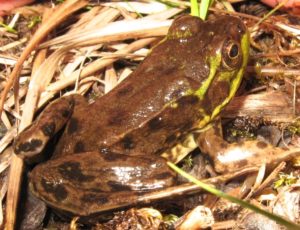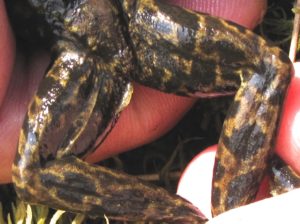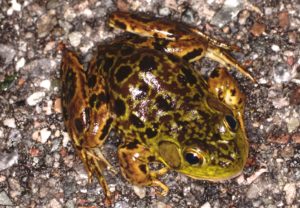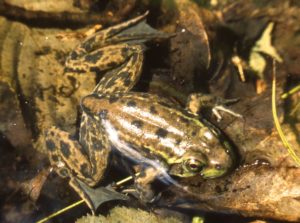Lithobates septentrionalis
Identification 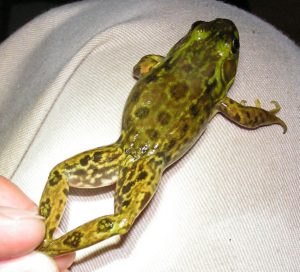
The Mink Frog is one of the three green-faced frogs in Vermont (the others are the American Bullfrog and the Green Frog). It measures 2-2¾ inches long. In Vermont, this species may or may not have dorsolateral ridges (folds of skin on each side of its back). The Mink Frog has dark oval spots oriented along the axis of its legs, unlike the Green Frog and the American Bullfrog, which have stripes perpendicular to the axis of their legs. It is also a heavily-spotted frog, but beware, both Green Frogs and American Bullfrogs are sometimes spotted.
The Mink Frog’s call sounds like horse’s hooves on cobblestones or two sticks being tapped together. It can be heard from May through July, most commonly in the middle of June.
This species can also be identified by its odor. When held, it releases a scent that smells somewhat like rotten onions. Consequently, it is sometimes referred to as the scratch-and-sniff frog.
Females lay eggs in round masses that can be as much as 3 feet below the surface. The masses are brownish in color and can have between 500-4,000 eggs. Tadpoles can spend more than one winter in the water before metamorphosing.
Get more detailed identification and life history information by downloading the chart here.
You can learn more about this species and see some video footage by checking out this clip from our Rattlers, Peepers & Snappers DVD.
Range/Habitat
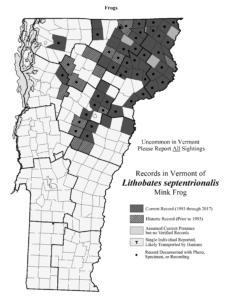
[ click image to zoom | download printable PDF ]
The Mink Frog is a northern frog, and Vermont is at the southern tip of its range. They are only found in the north central and northeast portions of Vermont and even there they are unusual.
Status
The Mink Frog has a state natural heritage rank of S3 (uncommon). In 2024, its status was updated to a species of special concern. Please report all sightings of this species in Vermont. Take photos if possible. Even historic sighting information is useful. Any natural history observations (feeding, migrations, road crossing areas, early or late season appearance, abnormalities, etc.) are appreciated.
Additional Photos
More Info
All the Vermont species listed in the Rana genus were reclassified into the Lithobates genus in 2007.
- Rana septentrionalis at Amphibiaweb
- Lithobates septentrionalis at Animal Diversity website
- Listen to its calls
at Frog Quiz
Species summary written by Ariel K. McK. Burgess.


